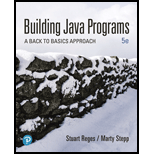
Concept explainers
Explanation of Solution
a.
Given code:
//Definition of class Test
public class Test {
//Definition of main class
public static void main(String[] args)
{
//Create an array
int[] numbers={8};
//Call the method
mystery5(numbers);
}
//Definition of method mystery4()
public static void mystery5 (int[] nums)
{
//Traverse for loop till it reaches the length
for(int i=0; i<nums.length-1; i++)
{
//Check whether "nums[i]" is greater than num[i+1]
if(nums[i]>nums[i+1])
{
&...
Explanation of Solution
b.
Given code:
//Definition of class Test
public class Test {
//Definition of main class
public static void main(String[] args)
{
//Create an array
int[] numbers={14,7};
//Call the method
mystery5(numbers);
}
//Definition of method mystery4()
public static void mystery5 (int[] nums)
{
//Traverse for loop till it reaches the length
for(int i=0; i<nums.length-1; i++)
{
//Check whether "nums[i]" is greater than num[i+1]
if(nums[i]>nums[i+1])
{
&...
Explanation of Solution
c.
Given code:
//Definition of class Test
public class Test {
//Definition of main class
public static void main(String[] args)
{
//Create an array
int[] numbers={7,1,3,2,0,4};
//Call the method
mystery5(numbers);
}
//Definition of method mystery4()
public static void mystery5 (int[] nums)
{
//Traverse for loop till it reaches the length
for(int i=0; i<nums.length-1; i++)
{
//Check whether "nums[i]" is greater than num[i+1]
if(nums[i]>nums[i+1])
{
&...
Explanation of Solution
d.
Given code:
//Definition of class Test
public class Test {
//Definition of main class
public static void main(String[] args)
{
//Create an array
int[] numbers={10,8,9,5,5};
//Call the method
mystery5(numbers);
}
//Definition of method mystery4()
public static void mystery5 (int[] nums)
{
//Traverse for loop till it reaches the length
for(int i=0; i<nums.length-1; i++)
{
//Check whether "nums[i]" is greater than num[i+1]
if(nums[i]>nums[i+1])
{
&...
Explanation of Solution
e.
Given code:
//Definition of class Test
public class Test {
//Definition of main class
public static void main(String[] args)
{
//Create an array
int[] numbers={12,11,10,10,8,7};
//Call the method
mystery5(numbers);
}
//Definition of method mystery4()
public static void mystery5 (int[] nums)
{
//Traverse for loop till it reaches the length
for(int i=0; i<nums.length-1; i++)
{
//Check whether "nums[i]" is greater than num[i+1]
if(nums[i]>nums[i+1])
{
&...
Want to see the full answer?
Check out a sample textbook solution
Chapter 7 Solutions
Building Java Programs: A Back To Basics Approach, Loose Leaf Edition (5th Edition)
- Describe three (3) Multiplexing techniques common for fiber optic linksarrow_forwardCould you help me to know features of the following concepts: - commercial CA - memory integrity - WMI filterarrow_forwardBriefly describe the issues involved in using ATM technology in Local Area Networksarrow_forward
- For this question you will perform two levels of quicksort on an array containing these numbers: 59 41 61 73 43 57 50 13 96 88 42 77 27 95 32 89 In the first blank, enter the array contents after the top level partition. In the second blank, enter the array contents after one more partition of the left-hand subarray resulting from the first partition. In the third blank, enter the array contents after one more partition of the right-hand subarray resulting from the first partition. Print the numbers with a single space between them. Use the algorithm we covered in class, in which the first element of the subarray is the partition value. Question 1 options: Blank # 1 Blank # 2 Blank # 3arrow_forward1. Transform the E-R diagram into a set of relations. Country_of Agent ID Agent H Holds Is_Reponsible_for Consignment Number $ Value May Contain Consignment Transports Container Destination Ф R Goes Off Container Number Size Vessel Voyage Registry Vessel ID Voyage_ID Tonnagearrow_forwardI want to solve 13.2 using matlab please helparrow_forward
- a) Show a possible trace of the OSPF algorithm for computing the routing table in Router 2 forthis network.b) Show the messages used by RIP to compute routing tables.arrow_forwardusing r language to answer question 4 Question 4: Obtain a 95% standard normal bootstrap confidence interval, a 95% basic bootstrap confidence interval, and a percentile confidence interval for the ρb12 in Question 3.arrow_forwardusing r language to answer question 4. Question 4: Obtain a 95% standard normal bootstrap confidence interval, a 95% basic bootstrap confidence interval, and a percentile confidence interval for the ρb12 in Question 3.arrow_forward
 Database System ConceptsComputer ScienceISBN:9780078022159Author:Abraham Silberschatz Professor, Henry F. Korth, S. SudarshanPublisher:McGraw-Hill Education
Database System ConceptsComputer ScienceISBN:9780078022159Author:Abraham Silberschatz Professor, Henry F. Korth, S. SudarshanPublisher:McGraw-Hill Education Starting Out with Python (4th Edition)Computer ScienceISBN:9780134444321Author:Tony GaddisPublisher:PEARSON
Starting Out with Python (4th Edition)Computer ScienceISBN:9780134444321Author:Tony GaddisPublisher:PEARSON Digital Fundamentals (11th Edition)Computer ScienceISBN:9780132737968Author:Thomas L. FloydPublisher:PEARSON
Digital Fundamentals (11th Edition)Computer ScienceISBN:9780132737968Author:Thomas L. FloydPublisher:PEARSON C How to Program (8th Edition)Computer ScienceISBN:9780133976892Author:Paul J. Deitel, Harvey DeitelPublisher:PEARSON
C How to Program (8th Edition)Computer ScienceISBN:9780133976892Author:Paul J. Deitel, Harvey DeitelPublisher:PEARSON Database Systems: Design, Implementation, & Manag...Computer ScienceISBN:9781337627900Author:Carlos Coronel, Steven MorrisPublisher:Cengage Learning
Database Systems: Design, Implementation, & Manag...Computer ScienceISBN:9781337627900Author:Carlos Coronel, Steven MorrisPublisher:Cengage Learning Programmable Logic ControllersComputer ScienceISBN:9780073373843Author:Frank D. PetruzellaPublisher:McGraw-Hill Education
Programmable Logic ControllersComputer ScienceISBN:9780073373843Author:Frank D. PetruzellaPublisher:McGraw-Hill Education





